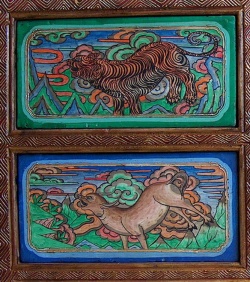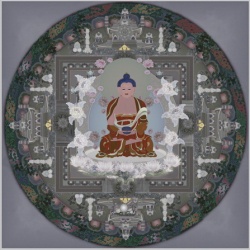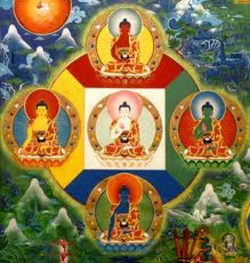Shambala (or Shambhala) is a mythical land
Shambala (or Shambhala) is a mythical land that, depending on one's interpretation:
A. Literally existed in ancient Tibet
B. Literally exists on another plane of existence that can only be reached by humans with sufficient spiritual advancement
C. Metaphorically exists in one's mind and heart.
Although commonly associated with Tibetan Buddhism, the concept of Shambala predates it, having been mentioned in prior texts of the ancient Zhangzhung culture and Bön religion. In Sanskrit, the word literally means "self powered" or "self determined".
In 1791, George Washington, Andrew Ellicott, and Pierre L'Enfant set about designing the new capital city of the United States, which would ultimately become Washington, DC. Elizabeth Clare Prophet, cofounder of the New Age organization Summit Lighthouse claimed that George Washington and the others were influenced by higher-dimensional beings to model their design plan for the city layout of Washington, DC after that of Shambala. (But since it's well documented that Washington inserted Masonic symbolism into that design plan, wouldn't that mean that Shambala is therefore a Masonic city?)
The concept of Shambala was seized upon in the 19th century by Theosophists like H.P. Blavatsky and Alice A. Bailey in the course of their controversial teachings. In two expeditions in 1926 and 1928, Soviet secret agent Yakov Blumkin attempted to discover Shambhala's physical location but (reportedly) failed. And then the Nazis sent three expeditions to the mountains of Tibet - first in 1930, and then in 1934-35, and then again in 1938-39. In each, the search for Shambala was a significant part of their mission.
During the same time period as the Nazi expeditions, rumors of the cryptozoological Yeti in this exact same region were also coming to a peak (no pun intended). Though many believe the Yeti to be an apelike humanoid, others maintain it's actually a Tibetan Blue Bear. If true, however, this is makes it no less fascinating, because the Tibetan Blue Bear is said by some to possess a much higher intelligence than the average bear. Perhaps this is why the animal is so secretive that it's considered one of the most elusive creatures on Earth today.
In 1957, a book entitled From the Subterranean World to the Sky: Flying Saucers was published by O.C. Hugenin, who suggested that the real Shambhala was not on a Tibetan mountain top, but rather underground as part of a "Hollow Earth" theory.
In 1959, a song called "Shombalor" was released by Sheriff and the Ravels. (The band was managed and produced by Hollywood actor Aki Aleong, whose screen credits include a 1964 episode of The Outer Limits called "The Expanding Human" with James Doohan, and also the original V television series.) The singer seems to be actually saying "Shambala" rather than "Shombalor" most of the time in the chorus. The lyrics are a staccato litany of gibberish phrases delivered at rapid-fire speed throughout the song, which contains references to Frankenstein, Albinos, Chickens, Nazis, and Bears. There's one significant exception: both the nonsense gibberish of the lyrics and the hypnotic loop of the melody stop abruptly to underscore one, and only one, lucid couplet:
Of all the animals in the world
I'd rather be a bear
Climb the highest mountain
Just because it's there.
In 1973, country-rock singer B.W. Stevenson had a minor hit (#66 on Billboard charts) with a very peculiar song called "Shambala". Click here to hear it.
Just one week later, the same song was released by rock band Three Dog Night and it became a smash hit, muscling out Stevenson's original version.
Three Dog Night's cover of the song was playing on an 8-track tape in the Dharma Initiative Volkswagen bus that Hurley and Charlie jumpstart in a significant moment on the ABC TV series LOST. Watch it here.
"Victory or Death", as Charlie says in that video clip, indeed. "Victory or Death" was George Washington's rallying cry at the Battle of Trenton, and also the password code among his men at the crossing of the Delaware River. Washington borrowed the slogan from the Scots, and years later it would in turn be borrowed by Adolf Hitler.


